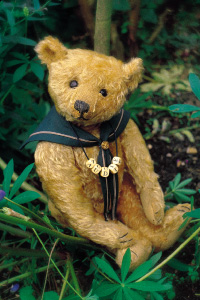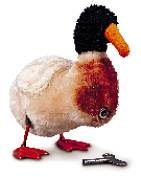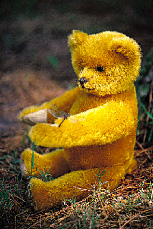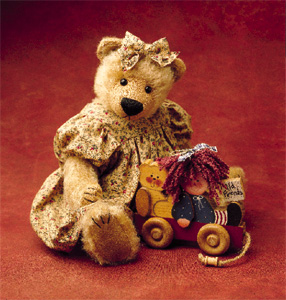|
This 16-inch Steiff was made about
1908 and comes from the collection of teddy bear artist
Audie Sison. Photo by Ho Phi Le Photo by Ho Phi Le |
By 1906, the teddy bear craze was in full swing in the United States. The excitement probably compared to the frenzy for Cabbage Patch dolls in the 1980s and Beanie Babies in the 1990s. Society ladies carried their teddies everywhere, and children had their pictures taken with their teddy bears. President Roosevelt, after using a bear as a mascot in his re-election bid, was serving his second term. Seymour Eaton, an educator and a newspaper columnist, was writing a series of children's books about the adventures of The Roosevelt Bears, and another American, composer J. K. Bratton, wrote "The Teddy Bear Two Step." That song would become, with the addition of words, "The Teddy Bear's Picnic."
Meanwhile, American manufacturers were turning out bears in all colors and all kinds, from teddy bears on roller skates to teddy bears with electric eyes. "Teddy bear," without the apostrophe and the s, became the accepted term for this plush bruin, first appearing in print in the October 1906 issue of Playthings Magazine. Even Steiff, a German company, adopted the name for its bears.
Steiff and Ideal were no longer the only players in the teddy bear business. In America, dozens of competitors sprang up. Almost all of these very early companies didn't last, with the notable exception of the Gund Manufacturing Corporation. Gund made its first bears in 1906 and is still making bears today.
American teddy bear companies faced stiff competition from all the teddy bears imported from Germany, and many of the U.S. companies didn't last long. In Germany, toy making was an old and established industry, and many German firms, such as Bing, Schuco, and Hermann, joined with Steiff in making fine teddy bears.
In England, The J.K. Farnell & Co. got its start; in fact, the original Winnie the Pooh was a Farnell bear Christopher Robin Milne received as a first birthday present from his mother in 1921. Five years later, his father, A.A. Milne, would begin to publish the Winnie-the-Pooh books about his son Christopher's adventures with his bear and his other stuffed animals. Today you can see the original toys that inspired the Winnie-the-Pooh books on permanent display in the Central Children's Room of the Donnell Branch of the New York Public Library in New York City, while the Pooh books themselves are as popular as ever.
More Great Years: The 1920s - 1940s
Made around
1929,
this
9-inch
mechanical
duck
by
the German
company of
Bing was
wound by a
key. Photo by Photo byTom Hockenberry |
This 12-inch Schuco
bear is called a yes/no bear, because this bear from the
1930s shakes his head no or nods yes, depending on how
you move his tail. Photo by Ho Phi Le Photo by Ho Phi Le |
With the exception of the four years when World War I raged in Europe, the next 25 years were kind to the teddy bear. Mass production had not yet taken over the teddy bear world, and people still preferred to buy high quality, hand-finished teddy bears.
Because World War I interrupted
the flow of teddy bears from Germany, new teddy bear industries
developed outside Germany. Chad Valley, Chiltern, and Dean's
joined Farnell in England; Pintel and Fadap were begun in
France, and Joy Toys in Australia. The bears themselves changed,
too. Boot-button eyes were replaced by glass, and excelsior
stuffing was replaced by a softer alternative, kapok.
The United States was relatively
untouched by the war, and its teddy bear industry continued to
grow. For example, the Knickerbocker Toy Company got its start
in 1920 and continues to make teddy bears today. Nine years
later, though, the U.S. was hit by the Depression, and most
teddy bear companies were hurt by the financial crisis. After
1929, many American companies either found cheaper ways to
produce bears, or they closed.
In the 1920s and 30s, musical
bears and mechanical bears were very popular, and they were
produced all over the world. Perhaps the most noteworthy
manufacturers of these novelty bears were Schuco and Bing. These
two German companies made bears that walked, danced, played
ball, and even turned somersaults.
But the outbreak of World War II
in 1939 stopped the fun. Instead of making teddy bears, the
world's workers and factories were needed for the war effort.
Some companies closed and never reopened.
The Lean Years: The 1950s, 60s and 70s
Made about 1970, this
20-inch bear from the German company of Fechter wears
its orignal ribbon. Photo by Tom Hockenberry Photo by Tom Hockenberry |
While traditional teddy bear companies had always prided themselves on quality hand-finishing and had always used natural fibers to make their bears, all that changed after World War II. Fueled by a desire for washable toys, synthetic fibers were all the rage in the post-War years. Buyers liked the idea of washable toys, so bears were made from nylon or acrylic plush, and had plastic eyes and foam rubber stuffing.
While traditional teddy bear
companies could adapt to this change in materials, they were not
prepared to compete against the flood of much cheaper,
mass-produced teddy bears coming from eastern Asia. Even the
old, well-established
companies were hurt by the onslaught of
inexpensive teddy bears from the Far East.
The Teddy Bear's Comeback: The Present
Strangely enough, the comeback of
the teddy after years of mass-production was triggered, not by a
bear maker, but by an actor. On television, British actor Peter
Bull openly expressed his love for teddy bears and his belief in
the teddy bear's importance in the emotional life of adults.
After receiving 2000 letters in response to his public
confession, Peter realized he wasn't alone. In 1969, inspired by
this response, he wrote a book about his lifelong affection for
teddy bears, Bear with Me, later called The Teddy Bear
Book. His book struck an emotional chord in thousands who
also believed in the importance of teddy bears. Without
intending to, Bull created an ideal climate for the teddy bear's
resurgence. The teddy bear began to regain its popularity, not
so much as a children's toy, but as a collectible for adults.
Jenni, an
18-inch bear, was made by British teddy artist
Elizabeth
Lloyd. |
In 1974, Beverly Port, an American dollmaker who also loved making teddy bears, dared to take a teddy bear she made to a doll show. At the show, she presented Theodore B. Bear holding the hand of one of her dolls. The next year, Beverly presented a slide show she had created about teddy bears for the United Federation of Doll Clubs. That show quickly became a sensation. Other people, first in the United States and then all over world, caught Beverly's affection for the teddy bear. They, too, began applying their talents to designing and making teddy bears. One by one, and by hand, teddy bear artistry was born with Beverly, who coined the term "teddy bear artist," often cited as the mother of teddy bear artistry. Today thousands of teddy bears artists, often working from their homes all over the world, create soft sculpture teddy bear art for eager collectors.
Artist bears also set the stage
for a new kind of manufactured bear, the artist-designed
manufactured bear. Today artist-designed manufactured bears are
offered by Ganz, Gund, Dean's, Knickerbocker, Grisly Spielwaren,
and others; all offer collectors the opportunity to own
artist-designed bears that cost less due to mass production.
American teddy bear
artist Heather Stanley made 14-inch Simon. |
This increased appreciation for the teddy bear as an adult collectible has also increased the value of antique teddy bears, the hand-finished, high-quality teddy bears manufactured in the first decades of the 20th century. In the 1970s and 1980s, these old, manufactured teddy bears began showing up in antique doll and toy auctions, and they began winning higher and higher bids. Today the current record price for one teddy bear, Teddy Girl by Steiff, is $176,000; that bear was sold at Christie's auction house in 1994.
So what's next for the teddy
bear? Certainly our love affair with the teddy bear shows no
signs of abating.
In 1999, in just the United
States, collectors purchased $441 million worth of teddy bears.
Certainly, as we begin our journey through a new century, we
certainly need the teddy bear's gift of unconditional acceptance,
love, and reassurance more than ever.
Thanks to Marianne Clay, Managing Editor, Teddy Bear and Friends


